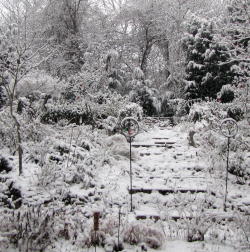
To be or not to be… better make that to be pleasing to the eye or to be relatively easy to take care of, or even keep alive, that is the question, but can’t we have both? Above shot: Hey, spring is easy.

The renovation of the Fairegarden continues with renewed vigor in the fall, for this is the time when evaluation reveals what works and what is playing possum, what is earning its place in precious soil and what is just taking up space. Above shot: The Japanese blood grass, Imperata cylindrica ‘Rubra’ certainly is a keeper. The Aster novae-angliae is too floppy for the wall and needs to be replaced with a dwarf aster of the same color. Never fear, it will be replanted elsewhere.

Requirements are many, of these living, growing, constantly changing botanics. The criteria include several months of visual interest if not year around appeal. This appeal can be had by the way a plant behaves while *dead*, illustrated in previous posts brilliantly titled Dying Well, Dying Well-Aging Attractively, and Dying Well-Fading Faire. (Click on any of these titles to read more, if you are so inclined.) Above shot: The Shed Bed is slowly going to sleep, Eryngium seedheads are brown bits to contrast the Belamcanda fan-like foliage that is beginning to turn golden shades whilst the seedheads reveal the reason for the common name, blackberry lily.

How plants look, the color and count of the blooms, the textural quality of the foliage, is followed by how well they grow in the sometimes dry, sometimes wet stony clay of zone 7 southeast Tennessee. Steeply sloping topography in a mostly sunny setting adds to the challenge. Above shot: The Gravel Garden looking towards the old steps of the house next door that was torn down to build the garage.

During this longest period of time tending a space in one’s gardening career, without pulling up stakes to move to yet another destination just as things were getting established, there has been the adding of diverse planting material like a demented artist throws globs of paint at the canvas. I am a hopeless collector, buying one of this and one of that in the ongoing experiment to see what works and what does not. Above shot: The front garden, with no lawn, designed for nearly zero maintenance. The weeping blue atlas cedar is flanked by two Cornus sanguinea ‘Arctic Sun’. The winter stems are a mix of gold, coral and red shades.

There have been failures, many and varied. Sometimes death occurs within days of planting, a painful process to a tightwadded psyche. Sometimes there is a slow, lingering demise, called the incredible shrinking plant. Healthy and robust when placed inground, each year sees it dwindle until there is nothing but a blank space with a forlorn tag to remind us of what once was. But, all gardeners know what a blank space means…buy more plants! Above shot: Perfect example of the incredible shrinking plant. It arrived lush and healthy a couple of years ago. Sigh.

Pretty and perky, that is the goal, easily propagated by seed or division to achieve the mass effect, the swath of sweet success that is lightly felt in the purse. Planting many of the same exact specimen close together has been a continuing struggle, for the instinct is to spread the wealth, try the new additions in several places to see how they perform, the dreaded plopping. But progress in that sector is being made. Above shot: The lower Gravel Garden. Lamb’s Ear planted close together!

The rungs of the ladder leading to garden Nirvana are slowly being scaled. Combinations for four seasons of interest in every portion of the property have been studied, noted, dissected and tweaked. The tweaking continues for the art of gardening is a journey, not a destination. Onward. Above shot: The stairway to heaven, heavenly gardening that is.
Frances









Oh my, not only have you given me courage to go out and look at the garden today but I will have the ear worm ‘Stairway to Heaven’ playing in my head. Have a great week and I hope you don’t find too many fatally fading plants.
Just the time of year for regeneration. We always get to a stage when we think and say the garden has never looked better. Before you know it we are out there digging up and making changes yet again.
Good advice in here, Frances. See what works, let go of what doesn’t. It’s a process… not a “one and done” as so many non-gardeners would like it to be. Plants grow, die, diminish, spread or not, and we are less in control than we think we are.
Dear Frances, There have been too many cases of the incredible shrinking plant happening in my part of Tennessee and let’s not forget plopping. Today as I ponder what the heck is working and what’s not, I’ll keep your advice in mind. I pinky swear I will work harder on drifts! xoxogail
Fall is a great time for assessing the garden, adding new plants and moving things around. If only I could get to those tasks. Today, I will for just a bit given your encouragement.
It is always reassuring to read that other gardeners suffer from the incredible shrinking plant:) My head is swimming with possibilities for changes in the garden this fall – my favorite time of year.
Every plant does have a journey. Some of mine outright curled up and died in our heat and drought this summer. Even with irrigation, it wasn’t enough to keep them alive. Others, did much much better. Your garden looks great Faire.~~Dee
Gosh Frances, I love that blue aster, I like the way it flops over the wall ,a beautiful counterpoint to the upright Japanese Bloodgrass.
So enjoy reading your blog everytime it appears in my inbox.
Happy fall gardening!
Sandra
You are so right about the art of gardening being a journey not a destination. If my garden was ever finished what would I do. 🙂 I’m also a hopeless plant collector so the garden is always a work in progress with a sometimes realistic and sometimes unrealistic goal in mind. lol
Oh my, the last photo does indeed remind me of ‘Stairway to Heaven’–so beautiful! I have had problems with several “incredible shrinking plants,” too, as well as some cases of unexplained sudden deaths this summer. I’ve been planning to walk around the garden soon with a clipboard, noting changes that need to be made next year. Evaluating what is working sounds like excellent advice as well.
Frances, I absolutely and completely “get” this. We’re on the same path, my friend.
Hi Frances,
I so agree, fall is an interesting time for evaluating what’s earning its keep and what isn’t. And because it’s a garden, we get to choose!
I’m relieved to hear it isn’t neglectful gardening practices that leads to the incredible shrinking plant, as you so aptly named. You’re right, too, about the tradeoff between aesthetics and low maintenance. My reluctance to do supplemental watering (except in emergencies) in NC dry summers means the garden doesn’t look so good in July and August. Few plants like 95 degree plus heat, dry soil and part shade! Maybe I should just move 🙂
Fall is inevitable but your garden looks wonderful. I’m trying to plant veggies for the Fall but it is still very warm here. Around 90 for the next few days. Some of it is up but still have to drag the hose to give them the drink they need till they can go on their own.
My Blackberry Lily was finished weeks ago. I did manage to get some seed. I hope they will come up next Spring when I will plant.
Exactly – the art of gardening is a journey, one with many twists, turns & surprises. You’re making excellent progress on reining in your collector tendencies. I have a very long way to go in that area. The phenomena of the incredible shrinking plant is most familiar to me.
Frances, you are bringing up a good question here! I am still in the phase of establishing a garden in a relatively small suburban lot, but sometimes the maintenance is already way over my head. So I really need to ponder this question, because a garden that can’t be maintained no matter how interesting the original planting might be will never be pretty in the long run.
Your garden never fails to impress me. I love the first and the last photo. You are very creative in the way you designed your gardens and I am sure that this isn’t a low maintenance garden. It is soo… lovely and interesting far away from being mainstream! Great job!
Christina
It’s hard when I trial a lot of plants and drifts take much valuable real estate. But when I do, it looks great. Oh well there’s always the back 40. 🙂